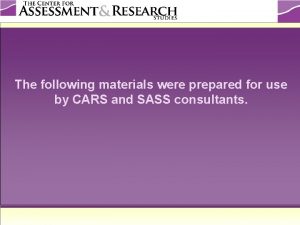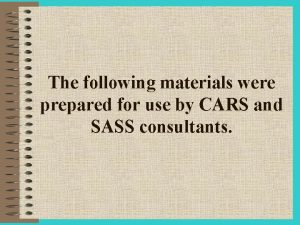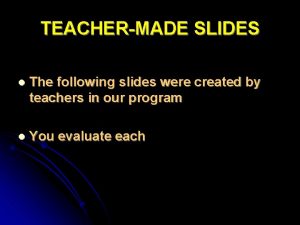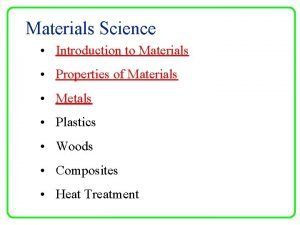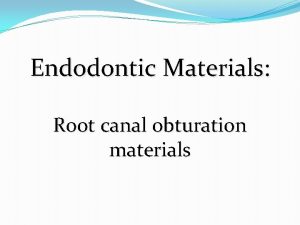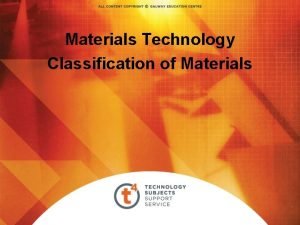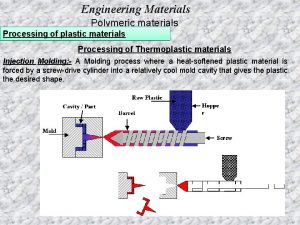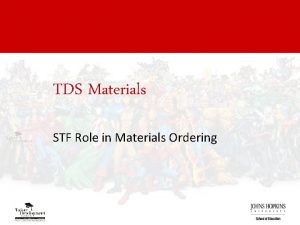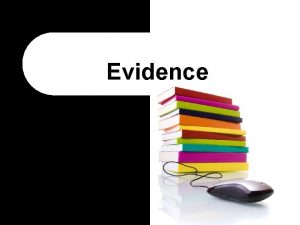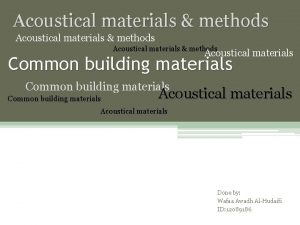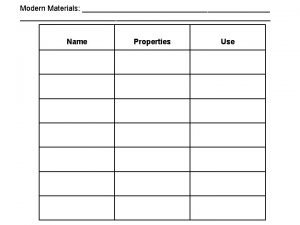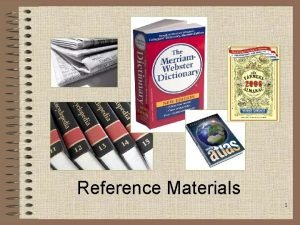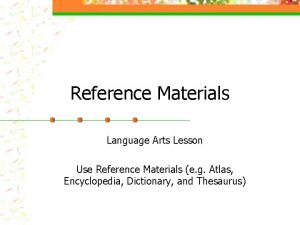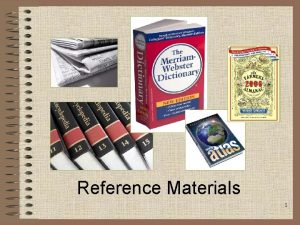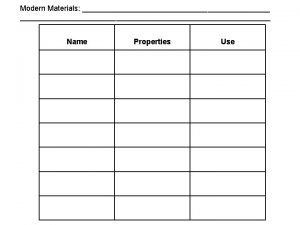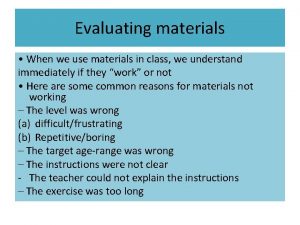The following materials were created for use in



















![Challenges/Solutions Challenges: • Allowing LEAs to Opt-Out of NIMAS [contracts/documentation] • Brailling new material Challenges/Solutions Challenges: • Allowing LEAs to Opt-Out of NIMAS [contracts/documentation] • Brailling new material](https://slidetodoc.com/presentation_image_h2/4576430fa460b5bc2e3effeb5806b728/image-20.jpg)













- Slides: 33

The following materials were created for use in a webinar presented on December 8, 2011 under the auspices of the National Center on Accessible Instructional Materials These materials may be used for educational and informational purposes only. Credits must be maintained. When referencing, please provide appropriate attribution. APA citation: Zabala, J. , Bobbett, J. , Downs, J. (December 8, 2011). What Works in Textbook Adoption States: Developing and Maintaining a System that Ensures Timely Delivery of AIM. Presented by the National Center on Accessible Instructional Materials. Retrieved [month, date, year] from http: //aim. cast. org/experience/training/webinars

Welcome to What Works in Textbook Adoption States: Developing and Maintaining a System that Ensures Timely Delivery of AIM Your speakers: Please mute your speakers upon entry. Access is located on the top navigation bar: Please add your name and affiliation to the chat text box on the lower right of the screen: Conference line: (800) 201 -2375 Passcode: 262160 Using *6 on your land line will mute/unmute your telephone audio. Tech support? Send an email to Ms. Hendricks: vhendricks@cast. org

Questions Please type your questions into the public chat box. They will be collected and directed to the presenters.

What Works in Textbook Adoption States: Developing and Maintaining a System that Ensures Timely Delivery of AIM presented by Jackie Bobbett, Louisiana Dept. of Education Jim Downs, Georgia Instructional Materials Center Joy Zabala, CAST and the AIM Center

Big Ideas for this Session • Quality Indicators for the Provision of AIM • Strengths, Challenges, and Lessons Learned for Two Selected Topics ✔ Provision of AIM in a Timely Manner ✔ Data Collection and Use

Accessible Instructional Materials The Statutory Connection Provisions within the Individuals with Disabilities Education Improvement Act of 2004 require state and local education agencies to ensure that textbooks and related core instructional materials are provided to students with print disabilities in specialized formats in a timely manner. Section 300. 172, Final Regulations of IDEA 2004

Accessible Instructional Materials The Statutory Connection In order to meet its responsibility…the SEA must ensure that all public agencies take all reasonable steps to provide instructional materials in accessible formats to children with disabilities who need those instructional materials at the same time as other children receive instructional materials. Section 300. 172, (b)(4)Final Regulations of IDEA 2004

Quality Indicators for the Provision of AIM 1. The education agency supports the provision of appropriate, high-quality instructional materials in specialized formats to all students with print disabilities who require them. 2. The education agency supports the provision of appropriate specialized formats in a timely manner.

Quality Indicators for the Provision of AIM 3. The education agency develops and implements written guidelines to define the responsibilities and actions needed for effective and efficient provision of specialized formats. 4. The education agency supports learning opportunities and technical assistance to facilitate the identification of students with print disabilities, as well as the selection, acquisition, and use of appropriate specialized formats.

Quality Indicators for the Provision of AIM 5. The education agency develops and implements a systematic process to monitor and evaluate the equitable, timely provision of appropriate, high-quality materials in specialized formats. 6. The education agency uses data to guide changes that support continuous improvement in the selection, acquisition, and use of accessible instructional materials.

Quality Indicators for the Provision of AIM 7. The education agency allocates resources sufficient to ensure the delivery and sustainability of quality services to students with print disabilities.

HOT TOPICS • Provision of AIM in a Timely Manner • Data Collection and Use

Provision of AIM in a Timely Manner Jackie Bobbett Louisiana Department of Education Office of Student and School Performance

Timely Manner The education agency supports the provision of appropriate specialized formats in a timely manner. Intent: IDEA requires states to define “timely manner. ” In general, “timely manner” means students with print disabilities receive instructional materials in specialized formats at the same time that non-disabled peers receive their instructional materials. Appropriate consideration is given to factors that could delay that access. Agencies have clearly defined policies and procedures to identify and address sources of delay.

Written policies and guidance are enhanced through organized support, ongoing technical assistance and professional development to school districts targeting the specific objective to provide accessible instructional materials to all students at the same time (i. e. , timely manner). This effort aligns well with the Departments vision to Create a World-Class Educational System for all students in Louisiana and with one of its overarching goals to eliminate student achievement gaps between students with disabilities and regular students.

Organized Support Publishers: • Mandatory orientation for publishers explaining NIMAS/NIMAC support and our student needs; contracts requiring publishing companies to provide standardized file formats for conversion to NIMAC • Contractual statement of preference for those companies who support state efforts to attain accessible formats for students with print disabilities.

Organized Support Local Education Agencies: • • • Pre-identified ordering avenues for all formats (i. e. , online ordering system/LIMC/LATI, Bookshare. org, and/or directly from the publisher) AIM web site. Standardized forms, memos, automatic notification to LEAs of order receipt/delivery/alternate action needed (i. e. , tracking). Local AIM-liaisons who troubleshoot and facilitate the implementation of AIM.

Technical Assistance • • Data collection systems that identify needs for AIM (web-based IEPs). Book ordering histories to project future AIM orders. LIMC/LATI conversions and acquisition of stateapproved materials. Flexibility which promotes the most efficient means for acquisition.

Professional Development • Promotes a professional learning community where key information and problematic areas are shared and addressed collectively. • Generates consensus grounded in current understanding of terms such as “Competent Authority” “core and core-related materials” and “Print Disability”
![ChallengesSolutions Challenges Allowing LEAs to OptOut of NIMAS contractsdocumentation Brailling new material Challenges/Solutions Challenges: • Allowing LEAs to Opt-Out of NIMAS [contracts/documentation] • Brailling new material](https://slidetodoc.com/presentation_image_h2/4576430fa460b5bc2e3effeb5806b728/image-20.jpg)
Challenges/Solutions Challenges: • Allowing LEAs to Opt-Out of NIMAS [contracts/documentation] • Brailling new material or state-editions [5– 8 month lead for conversion of new materials] Solutions: • Regular workshops that promote SEA/LEA analysis of student data • AIM Forums for sharing ideas, practices, promises, and pitfalls with one another

Always Room for Improvement • Official documentation and support for local budgeting, ordering, conversion, and removing barriers. • Correlation between timely delivery of stateapproved materials and student achievement/improvement/gaps.

Resources One-stop Shopping—Check it Out! • LEAs order all appropriate formats for all students online and then can visit the LA-AIM for support and additional resources LA-AIM web site http: //www. atanswers. com/aim/index. html • Downloadable Forms, Professional Development, Instructional Resources, Webinar Information, NIMAC and FAQs See also: http: //aimconsortium. cast. org/states/louisiana

Data Collection and Use Jim Downs Georgia Instructional Materials Center

Use of Data… The education agency uses data to guide changes that support continuous improvement in the selection, acquisition, and use of accessible instructional materials. Intent: Data are systematically analyzed to gauge effectiveness of current practice and used to inform actions needed to improve future practice.

Data Collection The education agency develops and implements a systematic process to monitor and evaluate the equitable, timely provision of appropriate, high-quality materials in specialized formats. Intent: Data are collected that measure the degree to which instructional materials in specialized formats are 1) provided to students with all types of print disabilities in an equitable manner, 2) provided at the same time as print formats, and 3) of quality sufficient to support appropriate instruction and achievement.

Uses of AIM Data Demographics – Age – Grade – Primary Disability Planning – – – Number of Books Used AIM Formats Cost Number of Students Primary Reading Devices

Uses of AIM Data Registration for American Printing House for the Blind Quota Funds • Blindness Type • Primary Reading Medium • Eye Report Data Program Justification • Cost Savings • Timeliness Correlation to Student Achievement • Test Data • Level of AIM Usage • Number of Years using AIMs

Uses of AIM Data Program Projection: –Future space, budget and personnel needs –Sourcing or production needs for specific formats –Reading technology needs –Training Validation –Format usage –Reading technology usage –Overall need

Strategies for Obtaining Useful Data • The software used for providing AIM must be designed with an eye on eventual data collection. • Software should be based on a standard database such as SQL which can share data with multiple sources and can easily feed data into Access, Excel, and pivot tables. • Ideally the software should bring together four areas; student data, patron orders, books differentiated by format, and external orders.

Strategies for Obtaining Useful Data • Identify a unique common identifier for the students. In Georgia this is the Georgia Testing ID (GTID). This provides the ability to connect to other student data such as test scores. • Consider instituting a policy of requiring student registrations with Bookshare and RFB&D to include this unique identifier so that you can include data on AIM usage from these sources. • Require annual student updates.

Resources Road Trip… Georgia Instructional Materials Center http: //www. gimc. org

Questions Please type your questions into the public chat box. They will be collected and directed to the presenters.

Thank you for joining us! AIM Center Webinar Evaluation When you exit the session, you will be taken to a very brief survey that is intended to gather information about the quality, relevance, and usefulness of the webinar you just attended. Your responses are very valuable, completely confidential, and greatly appreciated. http: //www. surveymonkey. com/s/WCMMPHC
 Sculpture is created by shaping or combining the materials
Sculpture is created by shaping or combining the materials The nazca lines were created by the mayans
The nazca lines were created by the mayans All things were created by him
All things were created by him How the world and mankind were created
How the world and mankind were created What basic problems were the opa and wpb created to solve?
What basic problems were the opa and wpb created to solve? Cant stop the feeling trolls go noodle
Cant stop the feeling trolls go noodle Harmful and useful material
Harmful and useful material Man made map
Man made map Adopting materials
Adopting materials Direct materials budget with multiple materials
Direct materials budget with multiple materials Fspos vägledning för kontinuitetshantering
Fspos vägledning för kontinuitetshantering Typiska novell drag
Typiska novell drag Nationell inriktning för artificiell intelligens
Nationell inriktning för artificiell intelligens Vad står k.r.å.k.a.n för
Vad står k.r.å.k.a.n för Varför kallas perioden 1918-1939 för mellankrigstiden?
Varför kallas perioden 1918-1939 för mellankrigstiden? En lathund för arbete med kontinuitetshantering
En lathund för arbete med kontinuitetshantering Särskild löneskatt för pensionskostnader
Särskild löneskatt för pensionskostnader Vilotidsbok
Vilotidsbok Sura för anatom
Sura för anatom Förklara densitet för barn
Förklara densitet för barn Datorkunskap för nybörjare
Datorkunskap för nybörjare Boverket ka
Boverket ka Mall för debattartikel
Mall för debattartikel Delegerande ledarstil
Delegerande ledarstil Nyckelkompetenser för livslångt lärande
Nyckelkompetenser för livslångt lärande Påbyggnader för flakfordon
Påbyggnader för flakfordon Formel för lufttryck
Formel för lufttryck Publik sektor
Publik sektor Kyssande vind
Kyssande vind Presentera för publik crossboss
Presentera för publik crossboss Vad är ett minoritetsspråk
Vad är ett minoritetsspråk Vem räknas som jude
Vem räknas som jude Treserva lathund
Treserva lathund Epiteltyper
Epiteltyper


































